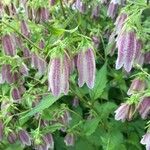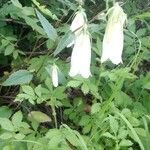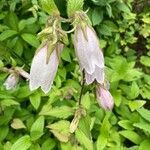Plants perennial, setose throughout or rarely subglabrous. Rhizomes long, horizontal. Stems erect, robust, 20-100 cm tall, usually branched above. Basal leaves long petiolate; blade cordate or ovate; cauline leaves ovate, lanceolate, or triangular, base rounded or truncate, margin irregularly dentate, apex acute or acuminate; lower leaves winged-petiolate, upper ones sessile. Flowers terminal on top of main stems and branches, pendent. Calyx lobes narrowly triangular; reflexed appendages elliptic, triangular, ovate, or lanceolate. Corolla white, yellow, or pink, commonly purple-or red punctate, tubular-campanulate, 3-6.5 cm. Capsule broadly campanulate or obconic. Seeds gray-brown, oblong or elliptic, slightly compressed, ca. 1 mm, smooth. Fl. Jun-Sep, fr. Sep-Oct. 2n = 34.
More
A small plant. It grows 30 cm high and spreads 45 cm wide. It keeps growing from year to year and forms clumps. The leaves are pointed and heart shaped. The flowers are tube shaped and hang down. They are cream with red spots inside. They are 8 cm long.



